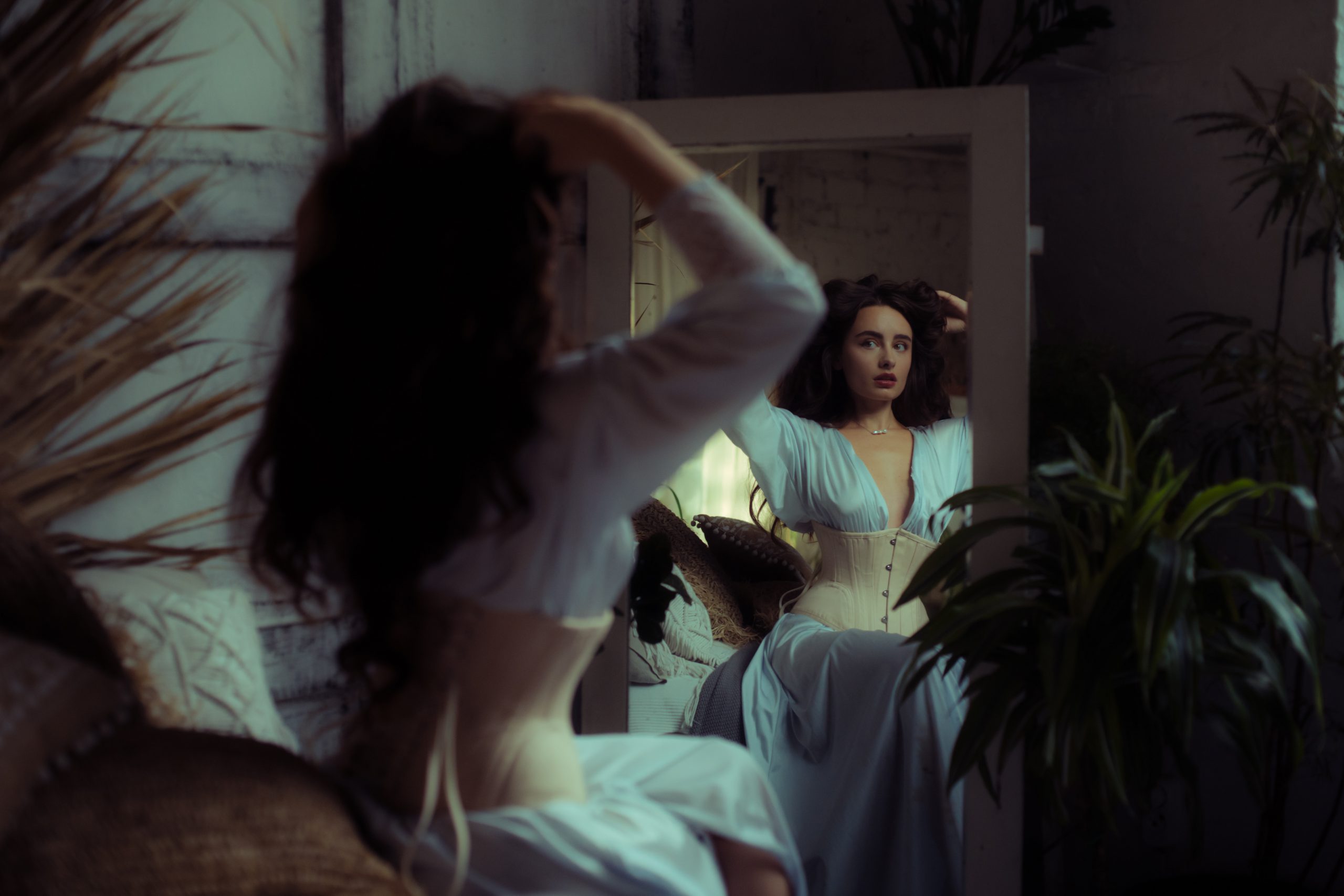
I’m glad you’re here. Can we talk? Converse and convey thoughts. Maybe sip tea or something fiery. Curl our feet beneath us. Fill the silences with understanding. Can we do that? I’ve been talking with women. And while that is every day, the central topic of discussion sizzles as part of an unwanted zeitgeist. Geist (the spirit of an individual or group) is more accurate than I’d like. What women are talking about is “silence.” The act of being made quiet, as though we are phantoms seen only in certain places but unheard.
In each conversational rotation with women, girls, and femmes who are either straining against societal restraints, sidestepping those constraints, or punching straight through them, I hear the phrase, “They want us in our place.” As though centuries were not enough. “They” can be anyone who subscribes to the idea women should be subservient, that we must fulfill designated roles, that our truth is not warranted nor wanted, or that our visions for ourselves can only be supported when we align with society’s dictates.
It sounds like women, girls, and femmes have been a little too vocal lately—for some. These conversations are as fraught as the third rail but, for those of us who are learning to ride the current, they are empowering. They say, “know your place.” Bet. We raze silence and counter with rage. Be it strategic, petty, revolutionary, educational, protesting, songwriting, legislating, academic, laid off or I quit, business launching, social media blasting—each approach is fueled by an undercurrent of anger at how things continue to be. Do not mistake anger as a lack of control or as singular. There are other emotions involved, but I am not as deft as the writers of “Inside Out.” Focus is needed. Still, I am similar to those filmmakers in one way. My chosen method of change is art, especially storytelling.
Young Adult properties and entire genres of manga, anime, and webtoons have been “on game” for decades. They’ve given us heroines (not to be confused with protagonists) of every emotional hue and disposition. And since those stories are aimed at female audiences nobody complains that they feature epically heroic girls—even when they’re brilliant or violent or “unfeminine.” Yet because television, streaming, and films are beginning to catch up in presenting a wider range of women as main characters, the wounded are many and their lamentations are vigorous.
In times like these, of course, women are more vocal and even more demanding for equity. Hello, SCOTUS. Those demands include representation in government but also in defining our fictional heroes. If we can be damsels and maids then we must also be knights and dragons, mages and ruling monarchs. As an ask, it isn’t unreasonable, but it has been met with a redrawing of the lines between what is acceptable femininity and what must be kept masculine. Some would prefer those lines be tattooed, so we never forget where we stand again. As an aside, let’s pause here to question: What do the hypermasculine contingents have against the color pink? A combination of red mixed with white that historically conveyed masculinity. It isn’t a marker denoting which men will betray the herd and join the Fembot Invasion. They are tripping balls. Or maybe they’re tripping over their balls. There is confusion either way.
“Why are angry women so threatening to others? If we are guilty, depressed, or self-doubting, we stay in place… In contrast, angry women may change and challenge the lives of us all… And change is an anxiety-arousing and difficult business for everyone…”
–Harriet Lerner, Ph.D., Psychology Today (Feb 2019)*
Art shapes culture. That is undeniable, but when it comes to recent epic heroines—whether they be reluctant, clever, or angry—our response to the culture is reshaping the art. Women are done with being constrained to prescribed roles and otherwise silenced. Therefore, our onscreen images are expanding to reflect the full spectrum of womanhood. This means the addition of more complex archetypes.

Although the archetypes were not AND are not the problem. Narrow definitions of what a woman can and should be onscreen are. We could be nice, pretty, or moderately intelligent. Manic pixies were always in play. We could be snarky, for sure, and we were allowed strength but not too much because that is somehow unrealistic. Combinations of those traits were also approved and despite the constraints, iconic heroines flourished: Ripley, Seline, Milla Jovovich as both Alice (“Resident Evil”) and Leeloo (“The Fifth Element”). There’s The Bride, and Sarah Connor too. Alongside others, these heroines attained pop culture status without an abundance of pushback. Likewise, in the realm of vengeance, “a woman scorned” became its own archetype. Yet even that had very specific motivations in effect.
“And when women are violent, it is usually only after they are mistreated by men. A dominant strain of female screen violence in the last 30 years has been “sexualised, hyper-personal revenge in response to rape or loss of a child.”
–Dr. Lisa Coulthard as told to BBC Culture (Oct 2022)
If we think about the iconic anger-fueled anti-heroines, within the framework of our focus on the epic ones (but exempting Horror because it is another landscape), we find that many of our favorite vengeance-seeking women have personal antagonists in the form of men who have done them wrong. And yet, if we go back to the motivations mentioned in the previous paragraph, another pattern pops up. I’ll call them thematic guidelines. The Bride from Kill Bill is out for payback against the titular Bill because he orchestrated a hit that killed her love and her unborn child. Thematic Guideline: Motherhood. Harley Quinn is reeling from the trauma of an abusive relationship. Thematic Guideline: Scorn. Foxy Brown attempts to hunt down her boyfriend’s killers only to suffer multiple sexual assaults, which amplify her need for revenge. Thematic Guidelines: Loss and SA. The ingenious Lisbeth Salander might have broken the paradigm with her wits but her quest for retribution is propelled by themes of Sexual and Mental Abuse. These angry heroines of the past are repeatedly corralled within gender lines, but they are also impelled by them. Even the most idolized follow the rules. In “Thelma and Louise,” the impetus is Sexual Abuse.
Emphatically, I must say, these themes are important. They are part of the truth of women’s experiences and must be part of the stories we tell—but only part. In understanding that, my research led to a realization. Male vengeance-seekers are not bound to the same thematic guidelines. They can seek revenge for any reason: the monsters of the apocalypses, failure to save the world, wrongful imprisonment, the murder of loved ones, or when someone kills their dog. Totally valid. They are even allowed to go on rampages for basic misunderstandings.
Who knew vengeance could be so freeing, friends?
Here’s the thing, the most duplicitous thematic guideline is one that cannot be crossed without raising ire among certain fans: A woman, no matter how heroic, worthy, or vengeful, must never be perceived as taking the place of a man. Otherwise, there will be Reddit blood. If some fandoms subscribe to the ideology that aggression or genius are male traits, they would inherently view epic heroines—whether violent or brilliant—as masculine and subsequently despise them. Why? For daring to step out of place.
What emerges is the idea some thematic motivations are masculine, while others are feminine, and the streams must not be crossed.
Look at Galadriel from “The Rings of Power” series. Some fans call her “Guyladriel” because she is depicted as a warrior in an earlier era called the “Years of the Trees.” She isn’t yet the powerful magic wielder she will become in Lord of the Rings during the Third Age, which occurs 4,000+ years later. [insert copious blinking here] Notice the use of “guy”—in mocking Young Galadriel—implies her warrior status makes her too manly. Translation, in their eyes: She is a dude. They want virtue, not swords and armor.

Similarly, there is the cast of “The Woman King.” The film features historic warriors from the Dahomey nation called The Agojie, an elite military unit comprised solely of women. Although the lead character Nanisca is a survivor of Sexual Abuse, the assault is not what defines her cinematic journey. Her ability to outwit, outmaneuver, and outfight male combatants does. And apparently, that is a problem. Groups who clamored for historical accuracy (but only for films like this) and others decrying the Agojie as myth, protested with the gnashing of teeth and the rending of khakis.
Let’s add the cast of the “Lost in Space” reboot because the four women leads are brilliant but varied and always ready for high-octane action. Once again, complaints were hurled with the velocity of a sudden meteorite shower. Some contingents said, “something is wrong with the science;” “this show isn’t believable,” they cried. What they meant was, the Three Robinson women could not be geniuses while dismantling a bunch of alien robots. Especially not through methods completely specific to the nature of their characters and their fields of expertise. Subconsciously, those anti-fans seemed to fume over how the creators of the series dared to allow these women to behave like men. But wait, the villain is a masterfully manipulative genius. too. Toxic stereotypes do not make space for that.
“It is apparent in how fans react to female TV characters that misconceptions about gender are still widely accepted. These norms prevent people from appreciating fictional female characters with the depth and complexity awarded to male characters. This is problematic, as it prevents females from being equally represented in media.”
–The Ontarion (Jan 2014), “Why Do Fans Hate Female Characters?”
Likewise, a contingent of LOTR fans demanded to know how Bronwyn, the healer from “The Rings of Power”—could kill an orc. I had one thought: “physics.” The pressure of her blade was stronger than his skin’s resistance to it and thus “off with his head.” There’s no mystery there, but what is mystifying is why the scene was questioned. Bronwyn is knowledgeable about humanoid anatomy by trade, why wouldn’t she rock an orc to permanent sleep when her life is at risk? She could. She did. The fact her son was also in danger didn’t help quell the disbelief. Perhaps prescribed feminine motivations are losing their hold, or maybe the writers could have upped the believability by killing off her son so Bronwyn could scream for “VENGEANCE” from on top of a snowy peak. Thematic Guideline: Motherhood and revenge.

Epic heroines shouldn’t be so narrowly defined that any divergence from “feminine guidelines” causes upset. On the flip side, there are exceptions we should talk about because their exceptionalism is relevant to our discussion. Going back to the concept of “Guyladriel” vs. Galadriel, magic is a seemingly genderless theme where women can flourish. This is true of mental and physical attributes, allowing for physical frailty and psychic abilities. Eleven in “Stranger Things” is a wonder because she is both a damsel and a deus ex machina. Behold, a 360-degree character.
Rey, from the third Star Wars trilogy, is the opposite. Breakdowns on the character say she is too gifted for no reason. Here is the question: Rey is basically a flat version of Luke. Which means she isn’t well-developed. Why the hate? I do not disagree that Rey can be defined as a Mary Sue, “a type of female character depicted as unrealistically lacking in flaws or weaknesses.” Still, it is hard to understand why so many anti-fans want to fight her for it. We’ve seen legions of male characters who are unnaturally gifted but we rarely question it. Instead, we attribute their inflated powers to “chosen one” tropes. But for many fans, Rey must provide provenance for her power. It must come from her father, or the Midi-chlorins, or anything that validates her because the newer epic warrior-women must prove they deserve heroic status in order to be liked.
Going back to the exceptions, let’s talk about writer/director James Cameron. Epic heroines who forge their paths to power are his bag, meaning he creates them with the skill of a mage. In the following, you’ll see how the feminine motivations we’ve been examining are established and then dissipated into smoke to leave an unquestioned warrior-woman behind.

First up is Ripley, the iconic heroine from the “Alien” franchise. In the first film, which is arguably a deep space horror movie, Ripley survives as the classic final girl or “the last woman or girl alive to confront the killer.” In the sequel, when Cameron takes over, Ripley’s transformation begins. Check the tropes in succession: she goes from the final girl (feminine trope) to mother/protector (borderline trope), and mid-movie she shifts to Lone Wolf and Cub, a traditionally masculine thematic framing. After that, although Cameron relinquishes the reins, Ripley is firmly established as an epic heroine and is no longer defined solely by thematically feminine motivations. Magic.
Cameron does it again with Sarah Conner in the “Terminator” franchise, taking her from damsel (feminine trope) to protective mother (feminine trope), and from there she metamorphoses into the bodyguard of THE ENTIRETY OF THE FUTURE. Once again, iconic. Finally, there’s Helen Tasker from “True Lies” (1994). At rise, she’s a disenchanted housewife (feminine trope), at the mid-point she becomes a pawn in the men’s games (feminine trope) but, by the end, she redefines herself as a sexy and unstoppable super spy (heroic trope). Bond who?
Fans were thrilled by Ripley, Sarah, and Helen, mostly likely because they start out in gender roles and transform over time and runtimes. These women are “in their place” initially but their growth forces them to “step out” and we witness their progression. Another point to consider, they were introduced at a time when they felt novel and less likely to shape the way women and girls see themselves in general. Sarah and Helen are also paired with strong male co-leads.
Either way, what her anti-fans don’t realize is, Young Galadriel as an elf, a survivor, a warrior, an egotist, a sap, a future magic wielder, and an angry princess, is also progressing toward the epic heroine we know she will become. Tolkien is not being betrayed. When we meet her in “The Rings of Power,” Young Galadriel is in the right place to begin a complex character arc. But she doesn’t have to be.
The latest batch of violent and brilliant heroic leading ladies should inspire more epic characters who reflect every archetype. Mad, clever, and fierce heroines are not made to replace male heroes; they are meant to fill the void. Because women are angry, the same as we are everything else humanity is capable of. It’s time we see ourselves as valid and varied and sometimes scary. The guys do it all the time. Otherwise, with the recent erosion of women’s autonomy, queer rights, and even the right to education, we are being told “they” have the right to their anger but no matter how we feel about it, we do not.
But that’s too grim. How about this? I know nothing about heroin but an epic and unapologetic heroine—aspirational, virtuous, or relentless—is my drug. They do not have to get everyone high. The ever-expanding landscape of television, film, streaming, anime, and video games makes room for heroes for everyone. Before now there were more for some of us than for others. There still are. Change is often forged in the fires of rage. Therefore, when it comes to toxic stereotypes, the contingents who support them do well by staying mad. Let’s call it fuel for the revolution.
After all, these violent delights have delighted fans.




